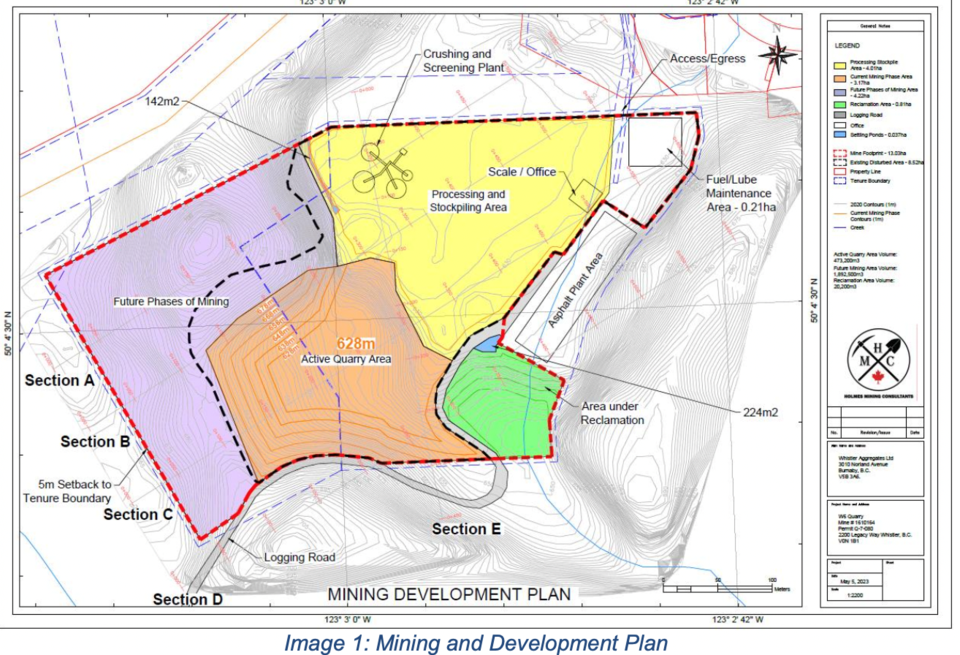An application to the province to significantly extend the mining permit and expand the mining area at a quarry in Cheakamus Crossing isn’t compatible with the fast-growing neighbourhood, according to the Resort Municipality of Whistler (RMOW).
On May 17, B.C.’s Ministry of Energy, Mines, and Low Carbon Innovation referred a permit amendment application to municipal staff from Whistler Aggregates Ltd., operators of the so-called W6 quarry, which is primarily mined for construction aggregate. There is also an affiliated asphalt plant on the site operated by Alpine Paving Ltd.
Whistler Aggregates applied to increase its proposed mining permit timeline to 30 years from the date of issuance, and to allow for the future expansion of the quarry area within the current Crown land tenure for extractions. If approved, the quarry would be developed in phases, and, after approximately 12 years, mining would expand beyond the current active quarry area, encompassing a total area of 7.39 hectares. The current quarry area is 3.17 ha. in size. (See map.)
The maximum annual tonnage extraction is proposed to remain essentially the same, at 99,999 tonnes per year.
Both municipal staff and council agreed the proposal doesn’t align with the needs of Whistler’s southernmost neighbourhood, the centrepiece of the RMOW’s current and long-term plans for affordable housing.
“There is a better use of that location: I think it’s community, I think it’s housing, I think it’s a place for families to be, and I hope we can find an alternative with the province and the operator,” said Mayor Jack Crompton.
On top of the hundreds of housing units already developed in Cheakamus, the construction of roughly 350 new employee units is being expedited on Lots 2, 3, and 5. Planner Joanna Rees also noted the potential for 500 additional units in the neighbourhood’s Lower Lands, as well as “potential to establish a complete community, with considerations for commercial space and institutional uses,” including schools and daycare.
Ultimately, council voted in favour of staff’s recommendation that, if the province does extend the Mines Act permit, the maximum permitted time should match the current occupation licence, which is expected to expire in 2027, or, notwithstanding, to a maximum of five years.
“There clearly has to be a timeline; 30 years is not reasonable. What we have here is reasonable,” said Councillor Arthur De Jong.
The RMOW is also looking to work with Victoria and Whistler Aggregates to review alternate locations within municipal boundaries for the W6 quarry and asphalt plant “to support current and future local aggregate and asphalt needs,” the report said.
That request is not without precedent. The asphalt plant has been a sore spot for previous councils and Cheakamus residents, who have raised concerns over its impact on air quality, noise levels, and industrial traffic on the one access road in and out of the neighbourhood.
In 2012, B.C.’s Supreme Court ruled in favour of Whistler Aggregates, allowing ownership to move ahead with plans to replace its aging asphalt plant with a new, modern facility, after the RMOW had sought a permanent injunction to force the plant out of its location in Cheakamus.
Around that time, the municipality had identified eight possible alternative locations for the plant, said RMOW staff, but Whistler Aggregates were not open to moving, citing, in part, the steep cost to relocate the facility. However, in 2017, when Whistler Aggregates first applied for a 30-year extension to its mining permit, a request that was denied by the province in favour of the current 10-year licence set to expire in 2027, RMOW staff indicated the company seemed more amenable to relocation.
“I don’t want this to be linear or heavy-handed because we need a quarry close in terms of climate,” said De Jong. “Is there a place we can land where we have a win, win, win—where we move in favour of the livability of residents that live close by, by finding another site, but not at a distance that we raise our carbon footprint? The third one would be so that it’s doable for the operator because I appreciate there is substantial cost to this,” said De Jong.
In 2020, the RMOW signed an agreement with Alpine Paving to work together to make safety improvements, as well as noise and dust reductions along the site access road, which included paving the road and installing a vegetated berm. The following year, the RMOW presented air-quality monitoring results from the neighbourhood, which met provincial standards on all days that were assessed, outside of periods when major forest fires burned near the resort.
As part of its comments to Victoria, the RMOW is seeking provincial support to complete an analysis of local aggregate supply and demand to meet the long-term needs of the community, including consideration of opportunities with the Lil’wat and 麻豆社国产Nations. It has also asked that Whistler Aggregates be required to undertake an environmental assessment of the impacts from the proposed expanded quarry area, something that, to staff’s knowledge, has never been done.
Council also passed an amendment at Tuesday’s meeting asking the province to update the distances listed in the application from the quarry to the nearest residential buildings on Cloudburst Drive, which officials believe to be inaccurate.
Although the RMOW has the opportunity to comment on the application, in the end, the decision will be left with the provincial ministry overseeing mine activity. After a requested extension, the municipality has until July 21 to provide feedback.




